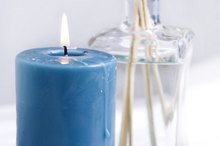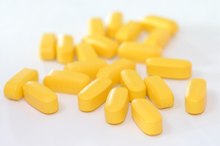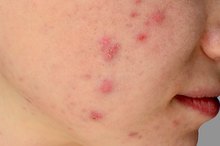How to Tell Acne From Staph
Staph infections are a product of the staphylococcus bacterium, which resides on the skin of humans but can cause serious medical problems if it gets beneath the surface and infects the blood 12. These infections have a relationship with acne that can go both ways--acne is sometimes the product of a staph infection, but can also be the cause if open wounds created by broken pimples become infected with staph 123. One type of staph infection leading to acne is folliculitis, which creates clusters of acne on the skin 3. It's important to know whether your acne is due to staph in order to address the infection before it gets worse 3.
If you are experiencing serious medical symptoms, seek emergency treatment immediately.
Identify any acne on your skin. Acne appearing on the face is more likely to be the result of clogged pores and greasy skin, since this is where acne is most prevalent. Wherever you find acne, check to see if the zits are broken open or if any red bumps appear on the skin. Keep an eye on these zits: it's normal for them to ooze liquid, pus and blood-like fluid, but if you notice red scabs that don't seem to heal, this could be a sign of a staph infection.
Home Remedy for an Infected Pimple
Learn More
Check for large, raised, red bumps on your skin. These are usually unbroken and are most commonly found on the body's "hot spots," such as the armpits and groin. If these bumps burst, they can be painful and secrete a blood-like liquid. They differ in appearance from acne in that they never develop a white head but instead are a boil-like blemish commonly associated with staph 3.
Determine whether the oozing from your skin is helping to relieve pressure and reduce the presence of acne or is resulting in the spread of acne. Fluids released from acne typically do not spread acne unless it carries the staph infection 3.
A Pimple-Like Rash All Over the Body
Learn More
Identify any unbroken lumps that are painful. Lumps resulting from acne are usually painful, while even the boils created by staph typically do not cause pain in early stages unless they are popped 13.
Locate any rashes developing among or around your acne spots. This could be a variant of the staph infection known as impetigo.
Visit a doctor to get your skin tested; this will determine whether you have an acne problem or a staph infection 3. It's important to do this as soon as you develop concerns you might have staph and could save you from further complications, pain or both.
Related Articles
References
- Acne Team: Do Staph Infections Cause Acne?
- Mayo Clinic: Staph Infections
- Med Help: Staph and Acne
- Harris A (Updated January 2019). Patient education: Methicillin-resistant Staphylococcus aureus (MRSA) (Beyond the Basics). Lowy FD, ed. UpToDate. Waltham, MA: UpToDate.
- King JM, Kulhankova K, Stach CS, Vu BG, Salgado-pabón W. Phenotypes and Virulence among Staphylococcus aureus. USA100, USA200, USA300, USA400, and USA600 Clonal Lineages. mSphere. 2016;1(3). doi:10.1128/CMR.00134-14
- Cleveland Clinic. (September 2019). Staph Infection (Staphylococcus Infection)
- Tong SY, Davis JS, Eichenberger E, Holland TL, Fowler VG Jr. Staphylococcus aureus infections: epidemiology, pathophysiology, clinical manifestations, and management. Clin Microbiol Rev. 2015 Jul;28(3):603-61. doi:10.1128/CMR.00134-14
- Sukumaran V, Senanayake S. Bacterial skin and soft tissue infections. Aust Prescr. 2016;39(5):159-163. doi:10.18773/austprescr.2016.058
- Bush L. (Modified June 2019). Merck Manual Consumer Version. Staphylococcus aureus Infections. (Staph Infections)
- De oliveira TH, Amorin AT, Rezende IS, et al. Sepsis induced by Staphylococcus aureus: participation of biomarkers in a murine model. Med Sci Monit. 2015;21:345-55. doi:10.12659/MSM.892528
- Harris A (Updated January 2019). Patient education: Methicillin-resistant Staphylococcus aureus (MRSA) (Beyond the Basics). Lowy FD, ed. Waltham, MA:
- Centers for Disease Control and Prevention. Invasive Methicillin-Resistant Staphylococcus aureus Infections Among Persons Who Inject Drugs. Six Sites, 2005–2016.
- Hassanzadeh P, Hassanzadeh Y, Mardaneh J, Rezai E, Motamedifar M. Isolation of Methicillin-Resistant Staphylococcus aureus (MRSA) from HIV Patients Referring to HIV Referral Center, Shiraz, Iran, 2011-2012. Iran J Med Sci. 2015;40(6):526-30.
- Chu C, Wong MY, Tseng YH, et al. Vascular access infection by Staphylococcus aureus from removed dialysis accesses. Microbiologyopen. 2019;8(8):e00800. doi:10.1002/mbo3.800
- Tong SY, Davis JS, Eichenberger E, Holland TL, Fowler VG Jr. Staphylococcus aureus infections: epidemiology, pathophysiology, clinical manifestations, and management. Clin Microbiol Rev. 2015 Jul;28(3):603-61. doi:10.1128/CMR.00134-14
- Romero-gómez MP, Cendejas-bueno E, García rodriguez J, Mingorance J. Impact of rapid diagnosis of Staphylococcus aureus bacteremia from positive blood cultures on patient management. Eur J Clin Microbiol Infect Dis. 2017;36(12):2469-2473. doi:10.1007/s10096-017-3086-5
- Missiakas DM, Schneewind O. Growth and laboratory maintenance of Staphylococcus aureus. Curr Protoc Microbiol. 2013;Chapter 9:Unit 9C.1. doi: 10.1002/9780471729259.mc09c01s28
- Kobayashi SD, Malachowa N, Deleo FR. Pathogenesis of Staphylococcus aureus abscesses. Am J Pathol. 2015;185(6):1518-27. doi:10.1016/j.ajpath.2014.11.030
- Centers for Disease Control and Prevention. (2019). Deadly Staph Infections Still Threaten the U.S.
- Centers for Disease Control and Prevention. (2011). Staphylococcus aureus in Healthcare Settings.
Writer Bio
Jonathan Croswell has spent more than five years writing and editing for a number of newspapers and online publications, including the "Omaha World-Herald" and "New York Newsday." Croswell received a Bachelor of Arts degree in English from the University of Nebraska and is currently pursuing a Master's of Health and Exercise Science at Portland State University.









